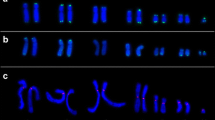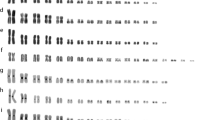Abstract
We performed a comparative analysis of the G- and C-banded karyotypes of seven species of didelphid marsupials, representing the three diploid numbers (2n = 14, 18 and 22) known to occur in this family. In addition to a great similarity among karyotypes with the same diploid numbers, we also identified homeologies for all autosomal arms comprising the three karyotypes. Robertsonian rearrangements, pericentric inversions and heterochromatin variation account for the differences among the karyotypes. Interspecific variation in the size of the sex chromosomes is due to differences in heterochromatic content. In-situ hybridization with total genomic DNA revealed considerable conservation of the euchromatic portions of the three karyotypes and indicated divergence of repetitive DNA sequences in autosomal heterochromatin.
Similar content being viewed by others
References
Casartelli C, Rogatto SR, Ferrari I (1986) Cytogenetic analysis of some Brazilian marsupials (Didelphidae: Marsupialia). Can J Genet Cytol 28: 21-29.
Engstrom MD, Gardner AL (1988) Karyotype of Marmosa canescens (Marsupialia: Didelphidae): a mouse opossum with 22 chromosomes. Southwestern Nat 33: 231-233.
Hayman DL (1990) Marsupial cytogenetics. Aust J Zool 37: 331-349.
Hayman DL, Martin PG (1969) Cytogenetics of marsupials. In: Benirschke K, ed. Comparative Mammalian Cytogenetics. New York: Springer-Verlag, pp 191-217.
Hayman DL, Moore HDM, Evans EP (1988) Further evidence of novel sex differences in chiasma distribution in marsupials. Heredity 61: 455-458.
Houseal TW, Cook JA, Modi WS, Hale DW (1995) Identification of highly conserved loci by genome painting. Chromosome Res 3: 175-181.
Merry DE, Pathak S, VandeBerg JL (1983) Differential NOR activities in somatic and germ cells of Monodelphis domestica (Marsupialia, Mammalia). Cytogenet Cell Genet 35: 244-251.
Palma RE (1995) The karyotypes of two South American mouse opossums of the genus Thylamys (Marsupialia: Didelphidae), from the Andes, and eastern Paraguay. Proc Biol Soc Washington 108: 1-5.
Palma RE, Yates TL (1996) The chromosomes of Bolivian didelphid marsupials. Occas Papers Mus Texas Tech Univ 162: 1-20.
Pathak S, Rønne M, Brown NM, Furlong CL, VandeBerg JL (1993) A high-resolution banding pattern idiogram of Monodelphis domestica chromosomes (Marsupialia, Mammalia). Cytogenet Cell Genet 63: 181-184.
Reig OA, Gardner AL, Bianchi NO, Patton JL (1977) The chromosomes of the Didelphidae (Marsupialia) and their evolutionary significance. Biol J Linn Soc 9: 191-216.
Rofe R, Hayman D (1985) G-banding evidence for a conserved complement in the Marsupialia. Cytogenet Cell Genet 39: 40-50.
Scherthan H, Cremer, Árnason Ú, Weier HU, Lima-de-Faria A, Frönicke L (1994) Comparative chromosome painting discloses homologous segments in distantly related mammals. Nature Genet 6: 342-347.
Seabright M (1971) A rapid banding technique for human chromosomes. Lancet 11: 971-972.
Souza MJ, Maia V, Santos JF (1990) Nucleolar organizer regions, G-and C-bands in some Brazilian species of Didelphidae. Brazil J Genetics 13: 767-775.
Sumner AT (1972) A simple technique for demonstrating centromeric heterochromatin. Exp Cell Res 75: 304-306.
Svartman M, Vianna-Morgante AM (1998) Karyotype evolution of marsupials: from higher to lower diploid numbers. Cytogenet Cell Genet 82: 263-266.
Toder R, O'Neill RJW, Wienberg J, O'Brien PCM, Voullaire L, Graves JAM (1997) Comparative chromosome painting between two marsupials: origins of an XX/XY1Y2 sex chromosome system. Mammal Genome 8: 418-422.
Yang F, O'Brien PCM, Wienberg J, Ferguson-Smith MA (1997a) A reappraisal of the tandem fusion theory of karyotype evolution in the Indian muntjac using chromosome painting. Chromosome Res 5: 109-117.
Yang F, O'Brien PCM, Wienberg J, Ferguson-Smith MA (1997b) Evolution of the black muntjac (Muntiacus crinifrons) karyotype revealed by comparative chromosome painting. Cytogenet Cell Genet 76: 159-163.
Yang F, O'Brien PCM, Wienberg J, Neitzel H, Lin CC, Ferguson-Smith MA (1997c) Chromosomal evolution of the Chinese muntjac (Muntiacus reevesi). Chromosoma 106: 37-43.
Yonenaga-Yassuda Y, Kasahara S, Souza MJ, L'Abbate M (1982) Constitutive heterochromatin, G-bands and nucleolus-organizer regions in four species of Didelphidae (Marsupialia). Genetica 58: 71-77.
Author information
Authors and Affiliations
Rights and permissions
About this article
Cite this article
Svartman, M., Vianna-Morgante, A.M. Comparative Genome Analysis in American Marsupials: Chromosome Banding and In-situ Hybridization. Chromosome Res 7, 267–275 (1999). https://doi.org/10.1023/A:1009274813921
Issue Date:
DOI: https://doi.org/10.1023/A:1009274813921




